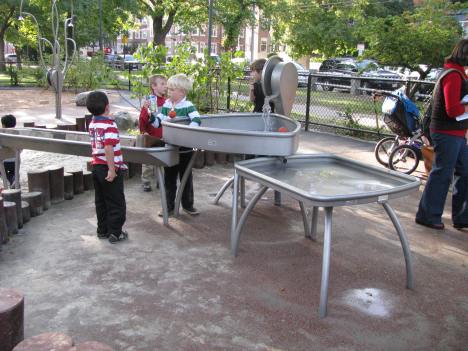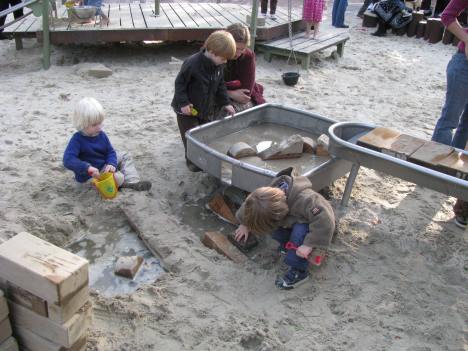Summer’s here, and as the temperature rises you’ve probably found your mind wandering to visions of hot sand and cool water. Imagine lying out in the sun, digging your feet into the coarse sand, and feeling the force of a wave coming from and receding back into the ocean. It’s enough to bring you back to your childhood, when sandcastles and splashing around at the beach was an exhilarating day.
Playing with sand and water may be one of the first ways we develop our cognitive understanding of the world. It helps a child understand the basic scientific laws of nature, and cause and effect. With all of the benefits, it’s easy to see why sand and water play should be integrated into the local playground.

The Alexander Kemp playground at Cambridge Commons in Cambridge Massachusetts is a perfect example of water and sand sensory play. With an array of interconnected water tables, troughs, and a hand-cranked pump, children are able to manipulate the flow of water from one table to the next, observing the changes as they happen. This helps them develop proto-scientific skills, and begs questions such as:
- What happens when you block the water flow with sand, or use a shovel as an impromptu levee?
- Is it possible to make the water stop? Why not?
- What happens when you use sand and mud instead of a shovel?
- Does sand float?
- Why does the water become muddy and then turn clear again?
It’s through this exploration and experimentation that children experience how organic and predictable physics in nature can be. Children begin to make mental connections through this experimentation, helping them further understand the world around them. The meanings of the words moist and muddy are completely abstract to a child until they can feel and sense it for themselves.

In addition to the sensory benefits of sand and water play, they also have the added benefit of being able to be manipulated and changed. Unlike your average playground structure that is solid, static, and unmovable, sand and water have the ability to be used in an almost infinite amount of ways. This leads to both a focused solo type of play, as well as opening the door for other social interactions and collaborations. The water table acts as a focal point for children and adults to gather in close proximity, giving them the option to work together or pursue more individual play.

With its ability to help aid in early childhood cognitive development, and early collaboration, it’s clear why sand and water play should be added to most public play spaces. Besides, when the sun is out and you’re burning up, who doesn’t love going to the park to cool down?

 RSS Feed
RSS Feed